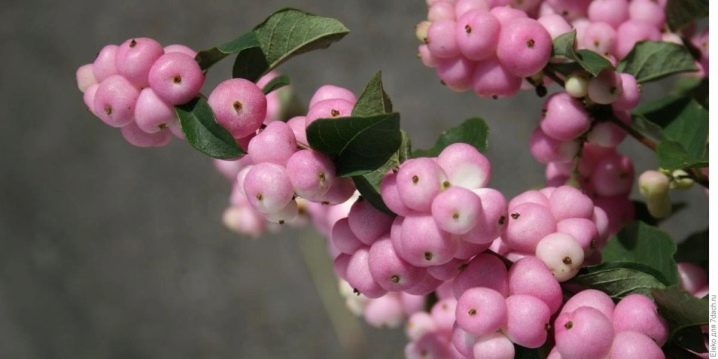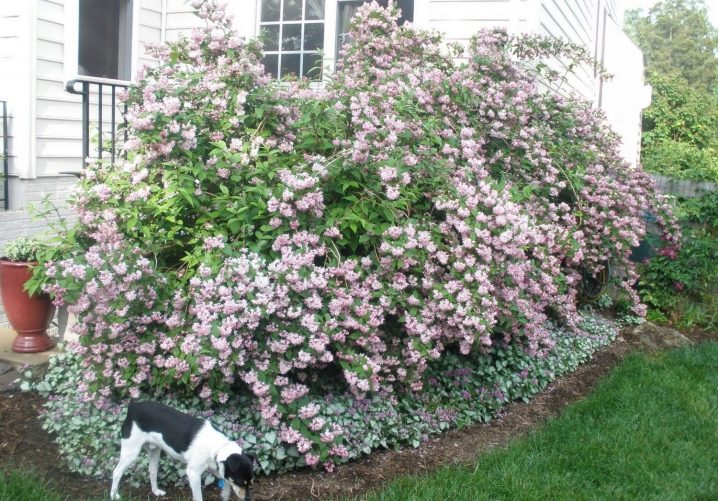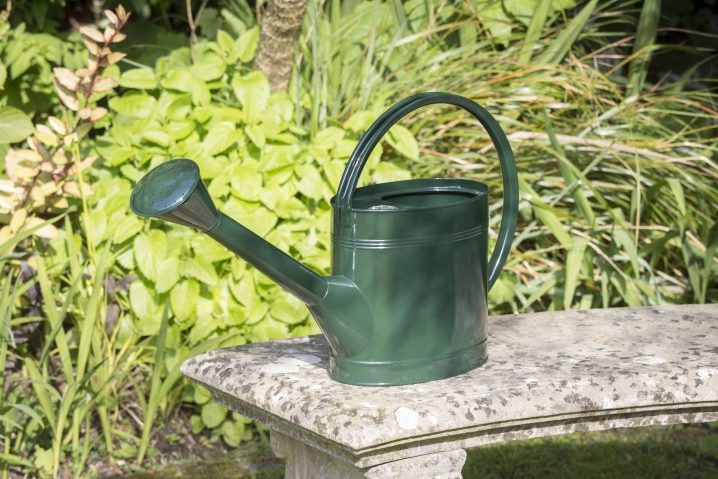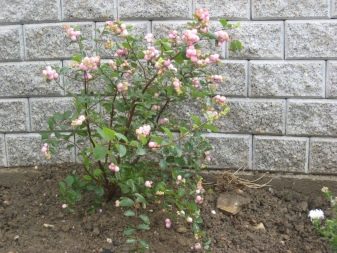Snowberry with pink berries

Snowberry with pink berries, or otherwise, snowberry pink, can give very good results for many gardeners. The description and use of a shrub with pink berries in landscape design deserves attention. It is necessary to carefully study all the nuances of planting and leaving.

Types and varieties
Speaking about the description of the pink snowberry, you must immediately indicate that it is an attractive deciduous shrub... Its height can reach 2-3 m. The presence of thin reddish or brown shoots is noted. Characterized by opposite leaves in the form of a rounded egg with a solid edge. The foliage becomes red in the autumn months.
In July and August, small bell-shaped flowers appear. Round fruits are completely inedible. The variety Folis Variegatis is in demand. It is appreciated for its unusual leaf color. The pattern on them is folded with a yellow curly border.
The bushes of this variety are covered with very decorative rich red berries in due time. The crown is compact and round. The height reaches 1.5 m, and the width can be equal to 1 m. The stems are thin, similar in shape to an arc, and at a young age are distinguished by dense pubescence. Pronounced fluff develops on dense elliptical leaves.
The flowers are relatively small and cream colored. Such flowers are grouped in inflorescences located in the axils of the foliage and at the tops of the shoots. Fruit can be expected at the end of September. The cultivar loves lighting and can even be grown on rocky ground. It is possible to trim such a culture without any risk.


An alternative is Taffs Silver Edge. It is a rare plant whose leaves have a white border and are not too large. Inflorescences visually resemble a brush. Flowering will last from July to October inclusive. Such a plant is hardy and staunchly tolerates rather severe cold.

Variety Amethyst extremely beautiful and also resistant to low temperatures. The bush reaches a length of about 1.5 m. The appearance of round white-pink fruits is characteristic. Such a culture can grow anywhere, just not in a dense shade. Straight drooping shoots are noted, a very long preservation of leaves and fruits at the end of the season.

Snowberry Maser of Pearl characterized by an ellipsoidal sheet plate. It has a greenish tint. The berries are relatively small and have a slight blush. The plant is light-requiring, can be grown in light partial shade. Other features:
-
drought resistance;
-
inadmissibility of a high level of groundwater;
-
wide-spread crown;
-
the formation of a dense carpet;
-
the appearance of roots from shoots touching the ground.

Magic Berry type can bear many fruits. The height of the shrub reaches 1.5-2 m. Cold resistance up to -34 degrees is guaranteed. Flowering will go on for a long time, and at the same time it will be very extensive. A spherical openwork type of crown is noted.

Snowberry White Hage produces moderately large white fruits. It is a rather dense bush that grows straight. In autumn, the foliage becomes yellow-white. The ability to grow in sparse soil is noted. Flowers in clusters may appear in June and July.

Landing
The time of planting the snowberry is chosen at your own discretion - both at the beginning and at the end of the season. In any case, the pits are prepared in advance. A gap of 1.2-1.5 m is left between the bushes.For a single planting, the hole should be 0.65x0.65 m in size.The openings are filled primarily with a drainage layer based on expanded clay or brick breakage.
On top of it, a soil mixture is poured, collected from the same doses:
-
sand;
-
peat;
-
humus.

It is helpful to add a feeding mixture that includes:
-
0.2 kg of dolomite flour;
-
0.2 kg superphosphate;
-
0.6 kg of wood ash.



Before disembarking, the roots are dipped in a clay chatterbox. Sprinkle seedlings with soil immediately. The root collar should remain outside. There are no more features at work. The choice of bushes is recommended for at least 2 years.
Care
During the usual summer rains, the snowberry does not need to be watered additionally. In this case, the natural moisture for the plant is already enough. If dry heat sets in, then every week 10-15 liters of water are used per bush.
It is useful to weed the area immediately after planting. You will have to repeat the procedure regularly.

Mulching the near-stem area can reduce its frequency. Mulch is also useful in dry years. You need to feed the snowberry only once during the spring, and repeat this in the summer and autumn. At the beginning of the growing season, 0.5 kg of humus is used. 0.1 kg of potassium salts and the same amount of superphosphate are added to it.
A liquid compound fertilizer is needed during the summer months. When at the end of autumn they dig up the earth around the trunk, 0.1 kg of superphosphate and 0.07 kg of potassium sulfate are embedded there. The snowberry almost does not get sick, and only in damp years it is necessary to treat powdery mildew or gray rot with fungicides. Prevention of fungal infection - treatment with diluted Bordeaux liquid. This bush is parasitized by aphids; with a weak invasion, wood ash helps, with a serious problem, you will need to use insecticides.
Crown shaping should be done before revitalizing the buds. At this moment, they get rid of the branches that have dried up during wintering. Excessively dense growth must also be removed. You can also not leave something that is infected with any infection.

After 8 years, the bushes are cut hard, leaving hemp no more than 0.4-0.5 m high.
Shrub in landscape design
The snowberry firmly tolerates the gas-polluted atmosphere. It is quietly planted even in large cities. In autumn, it contrasts perfectly with mountain ash, and in winter it sets off conifers. You can also create decorative spots on your lawn or flower bed. Finally, it is allowed:
-
creation of perennial soil cover under trees;
-
decoration of alpine slides;
-
creating a hedge around the perimeter or dividing the garden into zones;
-
combination with viburnum and hawthorn;
-
breeding in city parks.






























































The comment was sent successfully.